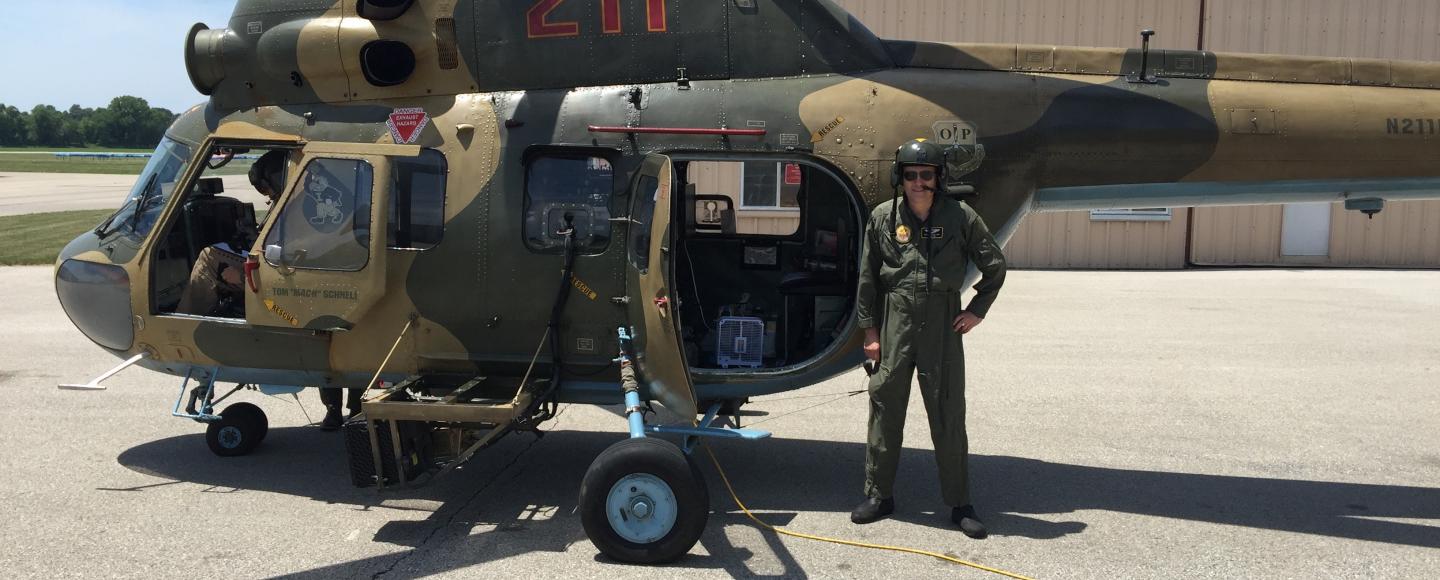Table of ContentsClose

What initially began as an everyday annoyance turned out to be a scientific discovery that has the potential to change the way clot-busting drugs are administered to stroke patients.
From his seventh-floor office in University of Iowa Hospitals & Clinics, Enrique Leira, MD, MS, could hear the noise of AirCare helicopters taking off and landing. But for Leira, that rumbling sound grew into a curiosity.
The Big Picture
Enrique Leira, MD, MS, is pictured with the Soviet-era Mi2 military helicopter used in his study to test if low-frequency vibrations may be beneficial for stroke patients treated with clot-busting medicine. Tom Schnell, PhD, MS, is piloting.
Many of his stroke patients arrived at the hospital by air, transported from local and regional hospitals not equipped for advanced stroke care. This practice is commonly referred to as "drip and ship," as patients receive a thrombolytic (tPA) infusion before being sent to the UI Stroke Center via helicopter. This clot-busting medicine is the only approved medical treatment for strokes.
“Anecdotally, we sometimes observed that it was not until they were airborne that the tPA started to work, and we wondered whether maybe there was more to this than a coincidental temporal association,” says Leira, a UI professor of neurology, epidemiology, and neurosurgery.
In other words, was there something about a helicopter ride that made the drug more effective?
In a collaboration with colleagues in the UI Carver College of Medicine and College of Engineering, Leira discovered that low-frequency vibrations, such as those associated with helicopter transport, may be beneficial for stroke patients treated with these clot-busting agents. The findings were published in the journal Stroke.
Colleague Tom Schnell, PhD, MS, UI professor of industrial and systems engineering, maintains a Soviet-era Mi2 military helicopter for research purposes and Salam Rahmatalla, PhD, MS, a UI professor of civil and environmental engineering and an expert in the effects of vibration study, operates a platform simulator that can reliably reproduce vibrations.
Preliminary feasibility studies, involving the UI AirCare team, showed that human research involving stroke patients could be carried out during air transport. From these findings, Leira received a grant from the National Institute of Neurological Disorders and Stroke to study the specific effect of those low-frequency vibrations in stroke patients who received tPA.
In a double-blind trial following an induced stroke, mice were randomized to be given the one-hour tPA infusion in three different settings: a Mi2 helicopter flight, a simulator of the Mi2 vibration signature, or in ground, or control, conditions.
The results showed a significant improvement in infarct volume and neurological outcomes using the simulated vibration, compared with the helicopter and control groups. The study authors report that low-frequency vibrations may be a novel, safe, and simple-to-deliver intervention that could improve the outcomes of patients.
Leira says the next task will be to optimize vibration for thrombolytic effect and determine its effects in additional animal models as well as those with co-morbid conditions. He also wants to identify possible extenuating physical factors during helicopter transport that negate the positive effect of the vibrations on stroke.
Several years of additional research will be needed before this treatment may be ready for human trials.
Additional collaborators include: Nirav Dhanesha, PhD, research assistant professor of internal medicine-hematology, oncology, and blood and marrow transplantation; Anil Chauhan, MTech, PhD, professor of internal medicine-hematology, oncology, and blood and marrow transplantation; M. Bridget Zimmerman, PhD, UI clinical professor of biostatistics; Daniel Thedens, PhD, research scientist in the Department of Radiology; Bradley M. Parker, with the Iowa Technology Institute in the UI College of Engineering; Jonathan DeShaw, PhD, a former researcher with Iowa Technology Institute; and Andrew A. Pieper, MD, PhD, professor of psychiatry at Case Western Reserve University and a former UI faculty member.

Stroke Center
The Stroke Center is recognized as a leader in the treatment and prevention of stroke.
